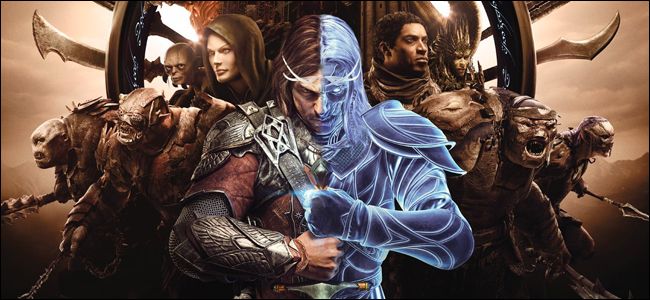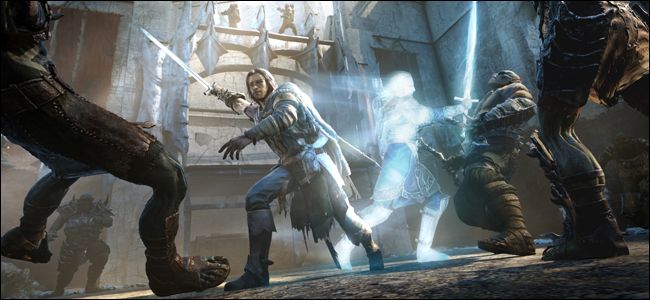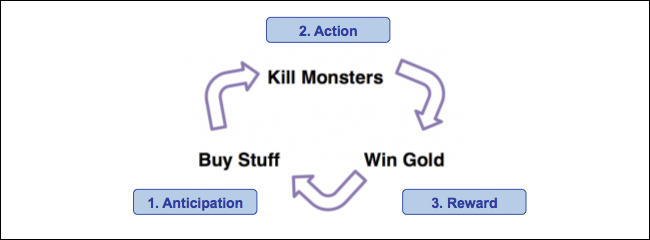
This weekend, while most of the technology and gaming press wasn’t working on anything particularly important, Warner Bros. Interactive tried to slip a small news item past their attention. Middle-Earth: Shadow of War, the highly-anticipated sequel to the Tolkien-themed adventure game Middle-Earth: Shadow of Mordor, will include microtransactions. This $60 game—up to $100 USD if you spring for the special pre-order versions—will ask players to pay even more in bite-sized chunks to unlock some of its content faster.
It isn’t the first time the small but infinitely extensible payments have jumped from free-to-play fare to the realm of full-priced PC and console releases. But for a variety of reasons, this one has been hit with instant and vocal backlash from gamers who were excited to take up Talion’s fight against Sauron once again. For one, we’re only two months out from release, and many gamers had already taken the bait of exclusive characters to pre-order the game (pre-order pushes and expensive bundles already being a casus belli for a lot of us) without being told about the microtransaction model the game would use. Another is that Warner Bros. Interactive has had a string of public relations failures with recent games, from the controversy surrounding YouTube reviews for the original Shadow of Mordor to the disastrous PC launch of Arkham Knight to the similar sequel-plus-loot box formula of Injustice 2.

But the bigger problem, for Warner Bros. and for gamers, is that there’s a sense of fatigue that comes with every major new release that succumbs to this model. The nightmare scenario of paying extra to reload the bullets in your digital gun, famously proposed by an EA executive just a few years ago, seems to be upon us in many ways. The pay-to-win systems so indicative of some of the worst trends in mobile games are coming to the PC and consoles, in full-priced, major franchise releases, and there’s nothing gamers can really do to stop it if we actually want to play those games.
The debate around the latest big release to lean on this model has been fierce. Some gamers are upset enough that they’ve cancelled their pre-orders and won’t buy it at full (or any) price, others are disappointed in the game and the general trend but plan to buy it anyway, and a small but vocal minority are saying that it’s not an important factor.
It is important, though. Pairing mobile, freemium-style microtransactions with a game at any price fundamentally alters both the way it’s designed and the way it’s played. Let’s take a look at some of the justifications for microtransactions in full-priced games, and why they don’t add up.
“Publishers and Developers Need the Extra Revenue”
No, they don’t. This is especially untrue of the biggest and most flagrant users of microtransactions in full-priced games, EA, Activision-Blizzard, Ubisoft, and Warner Bros. Interactive. These companies bring in huge slices of the estimated $100 billion dollar gaming industry, and would get big slices no matter what their revenue models were on specific games.

Since the discussion is about Shadow of War, let’s take a look at the numbers for its predecessor. For a AAA title from a major publisher, Shadow of Mordor was actually something of a surprise hit, with combined console and PC sales of approximately 6 million units according to VGChartz. At $60 a copy that would mean a revenue of roughly $360 million, but a lot of those copies were probably bought on sale, so let’s cut the estimated revenue in half to $180 million. Assuming that Shadow of Mordor had a production budget on par with similar games like The Witcher 3, it would be somewhere in the $50 million range to produce. With perhaps another $30-40 million in marketing and distribution costs, the game still would have made its money back for Warner Bros. at least twice over.

So, to imply that the sequel to Shadow of Mordor “needs” any extra revenue stream is disingenuous. And again, it’s hardly at the top of the high-budget gaming heap: the yearly installment of Call of Duty can be depended upon to make somewhere between $500 million and a billion dollars on its own, The Division sold over 7 million units for Ubisoft last year, and the FIFA 2017 soccer game sold over 15 million copies, making money at Hollywood blockbuster levels from initial sales alone. These are the extreme examples, of course, and every developer and publisher is expected to have its ups and downs, but to say that microtransactions are somehow unavoidable at the highest level of game sales is simply not true.
Oh, and The Division, FIFA 2017, and Call of Duty Infinite Warfare all included microtransactions, despite earning back their budgets multiple times over from conventional sales alone. EA’s Ultimate Team modes for its sports games, which reward the biggest spenders on in-game digital currency, earns the company $800 billion a year. The takeaway is this: standard video game sales can earn a mind-boggling amount of money at the highest level, enough to make any company profitable. Adding microtransactions on top of that is simply a way to squeeze every possible dollar out of development. That’s a really great thing if you’re an EA stockholder…but not so much if you’re a player.
“You Can Still Earn Everything In The Game Without Paying Extra”
This kind of reasoning often adorns some of the more exploitative free-to-play mobile games, and it’s no less appealing when it shows up on a game with a $60 price tag. It’s often repeated for games like Overwatch, and it even showed up in the official press release announcing Shadow of War‘s loot crate system.
Please note: No content in the game is gated by Gold. All content can be acquired naturally through normal gameplay.
That sounds fine, right? The only thing gained by the players who spend extra money is a little time. And indeed, that would be a fairly reasonable way to explain microtransactions and other paid extras…but the logic breaks down pretty quickly once you start to think about it.

Video games take more than just technical skill when it comes to design, and more than conventional artistic prowess as well. There are practical aspects of game design that have evolved over the last few decades as the medium has grown. Things like skill balancing, a difficulty curve, or even a compulsion or “reward” loop, are relatively intangible concepts that nevertheless help determine a game’s quality. And these elements are affected—in fact, can’t help but be affected—when microtransactions are built in.
These ideas can incorporate the player’s own skill, the danger of enemies, the frequency of rewards, and any number of other elements. But when you tie them in to a system that can be bypassed with real money, the progression is no longer exclusively reliant on time, or skill, or even blind luck. The developer and publisher now have a vested interest in changing the formula. And not so that the player doesn’t get overwhelmed or bored by poorly-leveled enemies, and not so the player is motivated to continue with periodic rewards. The question now becomes, “how infrequently can we reward the player—enough that they’ll continue to play the game, but not so frequently that they’ll have no…
The post Microtransactions in AAA Games Are Here to Stay (But They’re Still Terrible) appeared first on FeedBox.